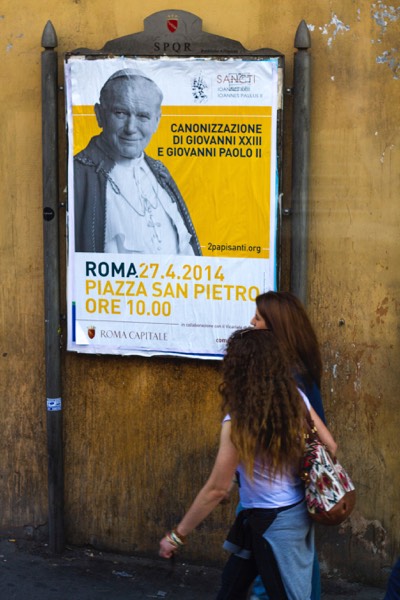
The two researchers delivered a paper on saint-making at the meeting of the Association for the Study of Economics, Religion, and Culture in Boston in late March, attended by Religioscope. The paper drew on statistics and historical records of popes from 1590 to 2012, finding an especially sharp increase during the two papacies of John Paul II and Benedict XVI, which is likely to continue with Pope Francis.
Barro and McCleary find that the “home bias” of the Catholic Church’s saint-making process is “remarkable,” with a substantial preference toward Italy and Western Europe. The effect of Protestant-Catholic competition and conflict in saint-making can be seen as early as the Peace of Westphalia in 1648, which negotiated truces between warring Protestants and Catholics; the numbers of saints canonized in the period before the truce was almost three times greater than those canonized after the agreement. The ending of this period of religious warfare in Europe “diminished the incentives of the Catholic Church to compete with Protestantism via saint-making.”
Using data that encompasses the numbers and characteristics of blessed persons selected by the 38 popes that started office since 1590, Barro and McCleary combined this information with estimates of populations for seven world regions and the proportion of Catholic, Protestant, evangelical, Pentecostal and Orthodox faiths. The economists find that since 1922, the higher rate of Protestant-Catholic competition has been an especially “important force on choices of blessed persons [beatifications].” They add that these results “suggest that choices of numbers and locations of blessed persons since the early 20th century reflect the Catholic Church’s desire to invigorate the Catholic faithful and avoid conversions to Protestantism.” Such competition takes place in areas where there is contact between Protestants and Catholics, with both communions having substantial numbers of adherents. No similar effect was found for Catholic-Eastern Orthodox competition, possibly because these churches have often agreed not to proselytize in each other’s territories.
The reason for the high numbers of beatifications and canonizations by Popes John Paul II and Benedict XVI may be due as much to “diminished standards for declaring persons to blessed.” One indicator of such lowered standards under the last two popes is their tendency to beatify previous popes. While both popes were similar in the high numbers of saints they canonized, far exceeding other popes, John Paul was the actual outlier. This is because Benedict inherited a high number of beatifications that John Paul II had made during his tenure that eventually required canonization. In the absence of this expansion by his predecessor, the number of saints canonized would have been more in the range of 15 rather than the observed number of 42, according to Barro and McCleary.
Pope Francis “definitely started with an enormous backlog of beatified—399, compared to 344 for Benedict XVI (and 105 for John Paul II). So, the number of saints for Francis should be correspondingly high. The real test for what Francis is doing with regard to blessed persons will be on the numbers beatified,” Barro told Religioscope in an interview by email. Barro and McClleary are currently studying the historical and geographical patterns of appointments of Cardinals in the Catholic Church, seeking to find out if such selections may exhibit similar patterns to that of saint-making.
Richard Cimino is the founder and editor of Religion Watch, a newsletter monitoring trends in contemporary religion. Website: www.religionwatch.com.